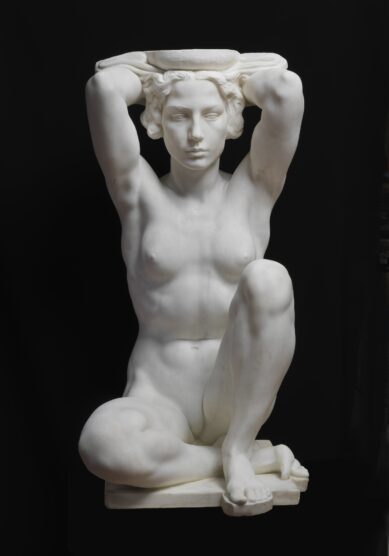(Trieste 1888 - Roma 1970)
Caryatid (c. 1925)
Measures: cm 93 x 40 x 48
Technique: marble sculpture
Provenance: Italy, private collection
Exhibitions: Prima mostra del Sindacato Laziale Fascista degli Artisti, Rome, 1929.
Specific bibliography: Prima mostra del Sindacato Laziale Fascista degli Artisti, Rome 1929, p. 42, no. 12; Uno sguardo d’insieme alla Mostra del Sindacato Laziale degli Artisti, in “La Stirpe”, 1929, no. 4, p. 224.
Essential reference bibliography: P. Marconi, Corriere architettonico: la fontana di Piazza dei Quiriti in Roma dello Scultore Attilio Selva, in “Architettura e arti decorative”, 1928, v. 1, no. 3, pp. 114-116; Giudizi e opinioni di osservatori romani sulla “sconvenienza” di Piazza dei Quiriti, in “Il Tevere”, 1 May 1928; F. Matitti, Fontane e fontanelle (1918-1945), in La capitale a Roma. Città e arredo urbano 1870-1945, Rome 1991, pp. 198-200, 207-208; G. C. de Feo, Attilio Selva (Trieste 1888 – Rome 1970): scultore a Villa Strohl-Fern, Rome 2010, pp. 29, 35-37; C. F. Carli, M. Carrera (eds.), Percorsi della scultura in Italia. Dalla Secessione al Novecento 1915-1935, Rome 2015, pp. 11, 29, 47-48; L. Masolini, Attilio Selva. L’enigma e il ritmo della forma, in M. Carrera, L. Masolini (eds.), Attilio Selva 1888-1970 Sergio Selva 1919-1980: dentro lo studio, Rome 2018, p. 52.
This white marble sculpture by Attilio Selva from Trieste is closely related to the fountain in Piazza dei Quiriti in Rome, which he designed and constructed. The protagonists of the monumental group are two pairs of seated caryatids in slightly different poses, positioned around a shaft and placed on a mixtilinear pedestal above a large basin, rhythmically alternating with each other: two have both arms raised, as they appear in the work in question, while two have one arm raised and the other resting on their foot.
The works for the construction of the fountain continued for more than four years, but not without coming up against obstacles. On 12 January 1924, the Municipality of Rome announced a tender addressed to all artists working in the country for the creation of five monumental fountains for the squares of some recently built neighbourhoods of the capital. Three of the eleven projects received were selected for Piazza dei Quiriti in the Prati district: those by Scipione Buratti, Publio Morbiducci and Attilio Selva. The latter – despite some doubts expressed by the selection commission, which criticised the preponderance of the figures compared to the lower part of the monument – was declared the winner in October of that same year. The artist’s initial idea was to represent the caryatids half-naked, covered in drapery up to the waist: only later did he undress them, resulting in their current appearance. This decision turned out to be somewhat inconvenient: in fact, close to the inauguration, the fountain was targeted by some Catholic associations, who attempted to censor it due to the nudity of the figures, which was considered scandalous. The protests were so heated, fuelled by the press through argumentative articles, that the inaugural ceremony, scheduled for 21 April 1928, had to be postponed by a few weeks, due to the failure of the then mayor, Ludovico Spada Veralli Potenziani, to take a position on the matter.
The work in question can clearly be dated to around 1925, i.e. to a period shortly after the artist’s decision to undress the caryatids. At the current state of knowledge, there is only one variant in bronze, bearing the mark of the Fonderia Laganà in Naples. However, it is the marble specimen, as specified in the catalogue, that is recognised in the Cariatide (studio per fontana) displayed in 1929 at the Prima mostra del Sindacato Laziale Fascista degli Artisti in Rome, at which Selva had a solo exhibition featuring an impressive twenty sculptures. Although the subtitle “Studio per una fontana” laid claim to its destination, the sculpture proved to be a work of solid artistic autonomy, especially when compared with the other nudes with which it interacted at the same venue, namely Sogno and Primula, sculptures in which the element of muscular torsion of the feminine body is central. The theme of the nude, in which he was particularly prolific, offered Selva the opportunity to fully express his own language, in which the modern stylistic features of the European Secessions – and of Ivan Meštrović, in particular – merged with the memory of Renaissance sculpture and the evocations which came to him from his knowledge of the artistic and archaeological heritage of Egypt, where he stayed in 1920 to work on the sculptures of the Abdin Palace in Cairo. The plurality of his references, reread through the filter of a personal interpretation and a technical execution of extraordinary skill, contributed to him becoming one of the most esteemed Italian sculptors of the time, as was also proven by the great success achieved at the solo exhibition in Rome. Despite an evident “Teutonic influence”[1], the Cariatide was positively received by critics, as had already been the case for the monumental fountain in Piazza dei Quiriti, which managed to find favour with the contemporary artistic scene despite suffering the defamatory accusations of outrage due to its brazenness. However, they were soon overcome, partly thanks to the backing of some of the artist’s supporters, such as the architect Plinio Marconi, who, in an article entirely dedicated to the fountain published the day after its inauguration, extolled «the plasticity of the figures, with vigorous and demanding flesh, yet healthy and chaste»[2].
Manuel Carrera
[1] Uno sguardo d’assieme alla Mostra del Sindacato Laziale degli Artisti, in “La Stirpe”, 1929, no. 4, p. 224: «Attilio Selva dopo aver attinto ampiamente alle stesse fonti di Mestrovich [sic] e di Bourdelle si dimostra assoluto padrone della forma e tenta con La madre di sfuggire al decorativismo che lo attira come nella Cariatide».
[2] P. Marconi, Corriere architettonico: la fontana di Piazza dei Quiriti in Roma dello Scultore Attilio Selva, in “Architettura e arti decorative”, 1928, v. 1, no. 3, p. 116.





